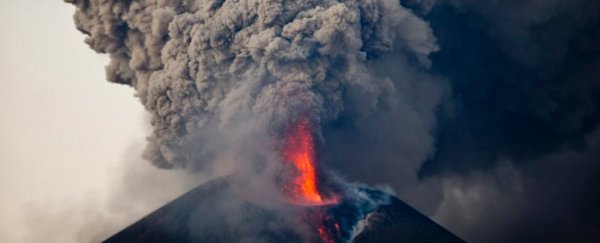One of Nicaragua's largest volcanoes, Momotombo, has started erupting for the first time since 1905, and it's putting on one hell of a show. Schools in the region have been evacuated, but fortunately for now the hot rock and ash "are heading toward very sparsely populated areas," says government spokeswoman Rosario Murillo.
Locals had reported feeling tremors in the region the past few weeks, and on Monday night the volcano blasted a plume of ash about 1,000 metres high. It was a strombolian eruption – volcanic activity that produces a range of continuous small explosions – and it produced a beautiful lava fountain, complete with glowing rocks tumbling down the slopes.
Since then, the volcano has continued to belch out gas and ash. Scientists still don't understand what makes volcanoes go silent for hundreds or thousands of years before waking up again, but there's evidence that this current eruption has been building since around 2003. As volcanologist Erik Klemetti from Denison University writes for Wired:
"As recently as 2003-2011, the volcano experienced a series of small seismic swarms that suggested magma moving in the system beneath the volcano. In 2007, the hydrothermal system in the summit crater began to heat as well, so this eruption may be the culmination of over a decade's worth of priming in the magmatic system."
It's not the only active volcano in Central and South America right now, with Fuego and Santiaguito in Guatemala both experiencing moderate eruptions. Nicaragua's Telica volcano has also had a restless 2015, with minor eruptive activity.
#Momotombo desde el cielo, una maravilla y nuestra del poder de la madre naturaleza pic.twitter.com/fb7cs48Dd5
— Canal 6 Nicaragua (@Canal6Nicaragua) December 3, 2015
All of these volcanoes are situated on the Cocos Plate, which is gradually slipping underneath the Caribbean Plate as a result of a process known as subduction. Subduction can create conduits for magma to escape to the surface, but it's not so clear exactly how that happens, or how long it takes.
By looking at the crystals in lava, geoscientists can get an idea of how long the material was kept at certain temperatures and pressures, and this provides clues about how long it took to reach the surface after formation.
But results of such analyses have shown that timeframes vary greatly. For example, some research has shown magma moving up to the surface in a matter of hours, while others suggest that the process takes centuries, as Klemetti told Live Science.
#Momotombo volcano spews plume of gas, ash & glowing rock, as seen from Papalonal, in Leon, Nicaragua. Jo pic.twitter.com/zYKZXLkDb0
— BBC Weather (@bbcweather) December 2, 2015
"There is no 'norm' for volcanoes, because it's all going to be up to the individual systems," he said. "Different volcanoes are going to have different periods of time based on all sorts of different things going on in the crust."
So how can we predict when eruptions are going to happen? The short answer is, we can't. Researchers have been trying to find a link between earthquakes and volcanic activity, but aside from a small relationship between earthquakes in Chile and volcanic eruptions six to nine months later, they've turned up empty handed.
Let's just be glad that for now Momotombo doesn't seem to be at risk of doing any serious damage. In the past the volcano was known to be incredibly active, and in 1605 it destroyed the then-capital of the region, León Viejo, which has since been rebuilt further west.
#Momotombo ruge, despierta y vuelve a su gloria pic.twitter.com/eNlsS5HHDX
— Canal 6 Nicaragua (@Canal6Nicaragua) December 2, 2015
Update 7 December 2015: We've updated the fourth paragraph to clarify that Momotombo is in Central America, not South America.
